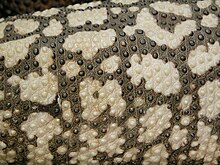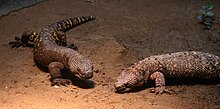Lizards
| Lizards | ||||||||||||
|---|---|---|---|---|---|---|---|---|---|---|---|---|

Gila crusty lizard ( Heloderma suspectum suspectum ) |
||||||||||||
| Systematics | ||||||||||||
|
||||||||||||
| Scientific name of the family | ||||||||||||
| Helodermatidae | ||||||||||||
| JE Gray , 1837 | ||||||||||||
| Scientific name of the genus | ||||||||||||
| Heloderma | ||||||||||||
| Wiegmann , 1829 | ||||||||||||
| species | ||||||||||||
|
The crustaceans ( Heloderma ) are a genus in the class of reptiles (Reptilia). These animals, native to the desert areas of North America, were long considered the only poisonous lizards with their two representatives; In the meantime, however, poison-producing tissue has also been detected in other lizards .
morphology
General
The head of crusty lizards is broad and slightly flattened. It merges with the cylindrical body with a short neck. The thick tail is rounded. Crusty lizards reach lengths of 60 to 80 centimeters, with the tail measuring around two thirds of the length of the head. The tail has 25–40 vertebrae. The short, strong legs have 5 clawed toes.
Scale dress
The dorsal side of crusty lizards is covered, in addition to the usual scales, with large, ossified horn scales at the base. The ventral side is characterized by flat, barely ossified shields regularly arranged in transverse rows. The pale yellow or orange to red spots or speckles are striking, which together with the rest of the black skin results in a high-contrast, conspicuous warning color that warns predators of the poison.
Dentition and organs with toxic connection
The teeth are designed as fangs and slightly curved backwards. The teeth of the lower jaw each have a longitudinal furrow on the front and back for introducing poison into the bite wound of an attacked organism. In contrast to poisonous snakes, the paired, 40 × 5 millimeter large venom glands are located on the rear edge of the lower jaw.
Occurrence
The two types of crustaceans occur exclusively in North America and northern Central America. The Gila crustacean is primarily found in part of western North America. The area they inhabit stretches from southern Nevada and southeastern Utah to Sonora in northwestern Mexico . The scorpion-crusty lizard lives in an area that stretches from northwest to southwest Mexico. The animals mostly inhabit arid deserts and semi-deserts. Prerequisites seem to be at least low rainfall and digging soil.
Way of life
General
Crusty lizards are mainly nocturnal, during the colder seasons they sometimes come out of their self-dug or natural or other animals built burrows during the day. Shortly after leaving their cave, lizards are sluggish, but become more active, more agile and faster as the night progresses.
nutrition
Crusty lizards prefer to eat nest- young rodents and other bottom -dwelling small mammals, both adult and young, as well as young birds , especially the bottom -dwelling species. Furthermore, eggs eaten various land animals. They find this prey by means of their Jacobsonian organ (perception of fragrances by licking the tongue, similar to snakes ) and kill the prey with their bite, here it can be a poison bite as well as a killing bite in which no poison is injected, but the injection is very rare of poison when hunting.
They store energy from food as fat in their tail, which is often very wide. This fat storage is consumed during climatic fasting periods, which are very frequent and long in the natural habitat of the crustacean lizards. The lizards also feed on tail fat for other reasons that prevent them from eating for a long time. Even if they then often become extremely emaciated, crusty lizards can survive fasting periods of several years if they are not active enough.
Reproduction and development
A while after mating, the females of the crusty lizards lay about three to 13 elongated and cylindrical eggs in more humid holes in the ground. After an incubation period of usually around 30 days, the young animals, usually around 20 centimeters long, hatch. Since they are usually not hunted due to their toxicity and size (possibly by coyotes , birds of prey and humans), they probably live to a great age. Some animals kept in captivity lived to be over 20 years old.
toxicity
The process of the poison bite
The lizards warn of the defensive bite with hissing and hissing. When the animals have bitten, they do not let go as quickly as possible, unlike poisonous snakes, but chew hard on the bite. The poison does not run through syringe-like teeth as in poisonous snakes and is injected directly into the victim, but runs from the venom gland in the lower jaw through a kind of groove between the jaw and lip using pressing movements and finally to the wound, where the poison enters the bloodstream of the victim. About 20 drops of poison are secreted per bite, the injection of these drops takes much longer than with other toxic organisms.
Symptoms, effects and use
Symptoms of a lizard bite include severe pain, swelling, blue-red skin discoloration, vomiting, nausea, increased body temperature, high blood pressure, and wound infections. It acts primarily on the central nervous system and sometimes kills by paralyzing the respiratory center. Mostly those bitten survive because the injected amount of poison is less than in other poisonous animals.
The poison is highly toxic. The LD 50 dose (poison dose at which 50% of the poisoned (test) animals die after a single application) for mice is 1.4 milligrams per kilogram of body mass. The crusty lizards use their poison almost exclusively for defense; it is rarely used in hunting.
Since November 20, 2006, a drug made from the saliva of the North American crustacean for the treatment of diabetes mellitus has also been approved in Germany. The active ingredient ( exenatide ) is said to have numerous advantages over conventional insulin preparations. For example, due to the better adjustability of the blood sugar level, frequent measurement of the same should no longer be necessary.
Systematics
General
Due to many special characteristics, the two crusty lizards are placed in the family Helodermatidae, which they establish. There are two subspecies of the Gila-crusted lizard (synonymous Gila animal or Gila monster), four of the scorpion-crusted lizard (synonymous with escorpion or scorpion-poison lizard). Systematic overview:
-
Genus crustaceans ( Heloderma )
-
Scorpion-Krustenechse ( Heloderma horridum )
- Heloderma horridum horridum ( Wiegmann , 1829)
- Heloderma horridum alvarezi Bogert & Martên del Campo , 1956
- Heloderma horridum exasperatum Bogert & Martên Del Campo, 1956
- Heloderma horridum charlesbogerti Campbell & Vannini , 1988
-
Gila crusty lizard ( Heloderma suspectum )
- Heloderma suspectum cinctum Bogert & Martên Del Campo, 1956
- Heloderma suspectum suspectum Cope , 1869
-
Scorpion-Krustenechse ( Heloderma horridum )
The two species can be differentiated, among other things, by their size (the Gila-Krusty lizard is about 60 centimeters long, the Scorpion-Krusty-lizard 80 centimeters) and the color (Gila-Krusty-lizard has larger and more conspicuously colored spots than the Scorpion-Krusty-lizard).
Tribal history
The oldest known fossils of crustaceans are the representatives of the groups Estesia , Gobiderma and Paraderma ; they come from the late Cretaceous . Eventually the tertiary groups Eurheloderma and Lowesaurus were discovered. In addition, finds were made which can be assigned to the groups that are more recent today. Gobiderma seems to be the most original form.
Endangerment, protection and continuance
There are currently no precise estimates of the population. Since 1986 the two species of crustaceans have been considered endangered. Since 1996, both species have been listed as " vulnerable " (endangered) in the IUCN Red List . Crusty lizards are endangered, among other things, by environmental pollution.
Legal
Crustaceans are considered dangerous animals in some federal states. In these federal states, their keeping requires a permit.
literature
- Heinz Wermuth: Family Krustenechsen. In: Bernhard Grzimek (ed.): Grzimeks animal life. Encyclopedia of the Animal Kingdom. Volume 6: reptiles. Bechtermünz, Augsburg 2000, ISBN 3-8289-1603-1 , pp. 322-324, (unchanged reprint of the original edition from 1979/80).
- Manfred Rogner : Lizards. Volume 2: Monitor lizards, skinks and other lizards as well as bridge lizards and crocodiles. Ulmer, Stuttgart 1994, ISBN 3-8001-7253-4 , pp. 9-13. Note: Served primarily as a source for keeping.
Web links
- Helodermatidae on Animal Diversity Web - Was evaluated as a source and therefore offers (almost) no information beyond the article, but further images are available
- Heloderma on gifte.de - Was evaluated as a source, therefore offers (almost) no information that goes beyond the article, but other images are available
- Heloderma horridum in the endangered Red List species the IUCN 2006. Posted by: Beaman, KR, 1996. Accessed November 26 of 2006.
- Heloderma suspectum in the endangered Red List species the IUCN 2006. Posted by: Beaman, KR, 1996. Accessed November 26 of 2006.
- Heloderma suspectum on digimorph.org
- Heloderma in The Reptile Database
Individual evidence
- ↑ LD 50 of the mice from: http://www.gifte.de/Gifttiere/heloderma.htm
- ↑ Private keeping of lizards only permitted with permission - Hessischer Verwaltungsgerichtshof, judgment of August 26, 2010, 8 A 121/10, free-urteile.de



